
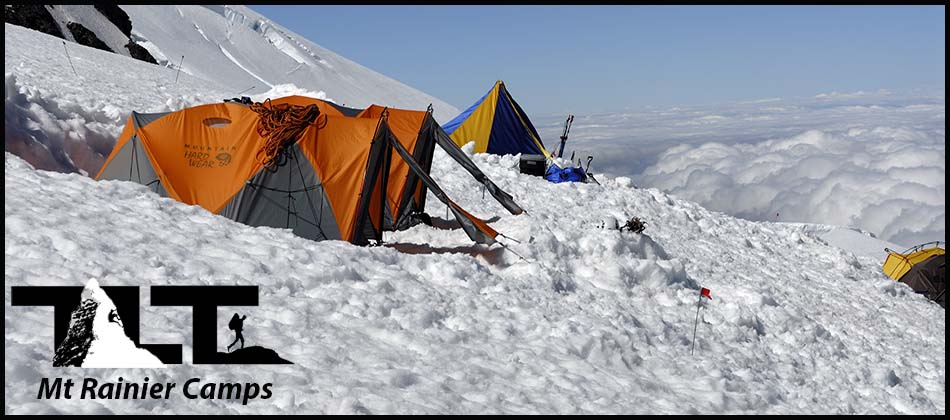 The Most Popular Rainier Camps by far are Muir Camp (photo below) and Ingraham Flats (shown above). Most summit attempts are made via these two camps (Muir Camp being the most popular). Muir is located at an elevation of 10,080 feet above sea level and it is the camp of choice for two day climbs on Mt Rainier. Camp Muir has a structures for the guides/cooks, clients, rangers, outhouses, and a public hut. There are also tent camping areas near the shelters. The area is extensively used by the National Park and Guide Services. But unless you are part of a guided group, you must use the public shelter or tent camping areas. We used the Public Shelter for our climb, since we did not make use of any Guide Services.
The Most Popular Rainier Camps by far are Muir Camp (photo below) and Ingraham Flats (shown above). Most summit attempts are made via these two camps (Muir Camp being the most popular). Muir is located at an elevation of 10,080 feet above sea level and it is the camp of choice for two day climbs on Mt Rainier. Camp Muir has a structures for the guides/cooks, clients, rangers, outhouses, and a public hut. There are also tent camping areas near the shelters. The area is extensively used by the National Park and Guide Services. But unless you are part of a guided group, you must use the public shelter or tent camping areas. We used the Public Shelter for our climb, since we did not make use of any Guide Services.Full time rangers are on duty at the camp during the main climbing season which goes from late May through mid September, and are very helpful should you need some assistance. The Public Shelter at Camp Muir can accommodate 30 climbers overnight and is open year-round, and has an emergency radio on hand inside. It is a great option, especially if there are high winds on the mountain. A noisy flapping tent does not make for a good nights sleep not to mention the difficulty of setting your tent up in a blizzard. On the other hand, the public shelter has climbers coming in and going out at all hours of the day and night, and this can certainly interrupt your sleep too. So if you make use of the public shelter, please try and be considerate and be as quiet as possible as you go about your business inside the shelter. But all that being said, Camp Muir is located in a spectacular location as you can see in the image below (note Mt Adams in the upper right hand portion of the photo).
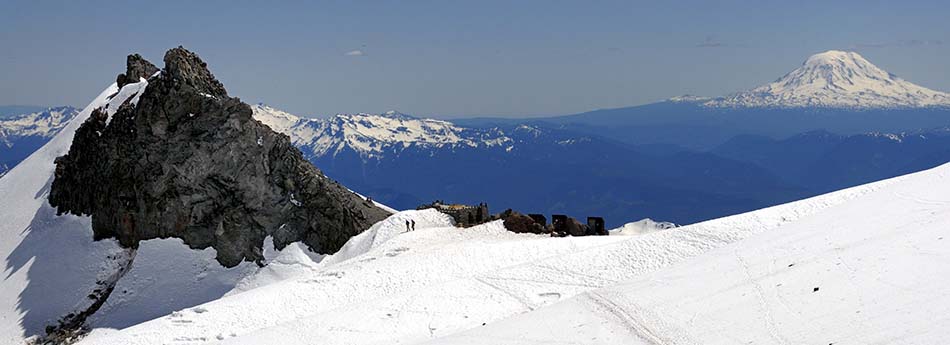 Below you see a photo of the Camp Muir Public Shelter (both outside and inside). It is a very sturdy structure but can be cold and a bit drafty in a storm, but as mentioned above, it is the better option when the weather turns for the worse as most ofter it does.
The camping area also has a toilet and a place to deposit your blue bags.
Below you see a photo of the Camp Muir Public Shelter (both outside and inside). It is a very sturdy structure but can be cold and a bit drafty in a storm, but as mentioned above, it is the better option when the weather turns for the worse as most ofter it does.
The camping area also has a toilet and a place to deposit your blue bags.
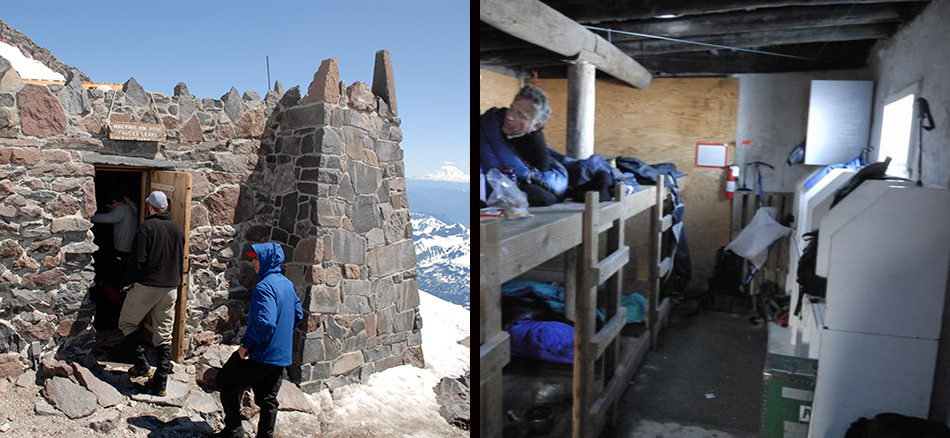 Next we move on to Ingraham Flats Camping Area, and just like Camp Muir, it is located in a spectacular setting (as seen in the photograph below). It is situated at the 11,100 foot level on Mt Rainier. No structures here, tent camping only as seen below, and there is a limit of 35 people that they will allow to camp overnight at Ingraham Flats. Camp Muir allows 110 people for overnight camping. Note the pyramid type peak in the left hand portion of the image. This landmark is known as "Little Tahoma." It is a satellite peak on Mt Rainier and can be seen from Seattle over 60 miles away. It tops out at 11,138 feet. Lots of rotten rock on Little Tahoma and because of this, I would not consider it a safe or enjoyable climb, but people do take the time to climb it and if taken into consideration as its own peak, it would be the third highest in the state of Washington.
Next we move on to Ingraham Flats Camping Area, and just like Camp Muir, it is located in a spectacular setting (as seen in the photograph below). It is situated at the 11,100 foot level on Mt Rainier. No structures here, tent camping only as seen below, and there is a limit of 35 people that they will allow to camp overnight at Ingraham Flats. Camp Muir allows 110 people for overnight camping. Note the pyramid type peak in the left hand portion of the image. This landmark is known as "Little Tahoma." It is a satellite peak on Mt Rainier and can be seen from Seattle over 60 miles away. It tops out at 11,138 feet. Lots of rotten rock on Little Tahoma and because of this, I would not consider it a safe or enjoyable climb, but people do take the time to climb it and if taken into consideration as its own peak, it would be the third highest in the state of Washington.
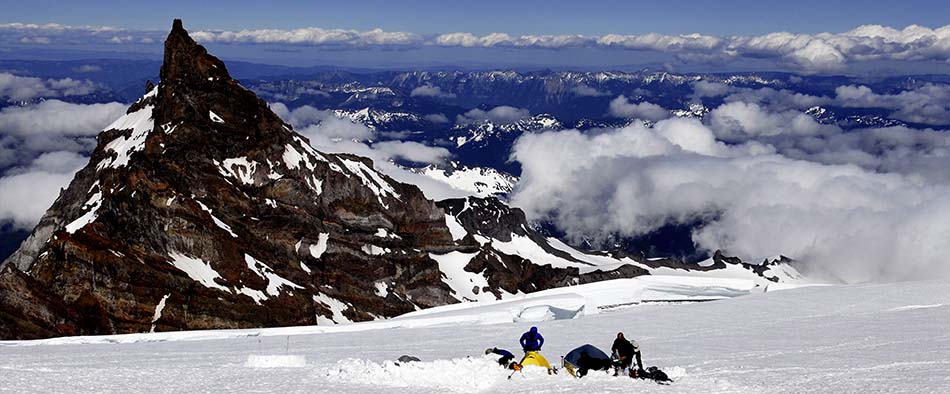
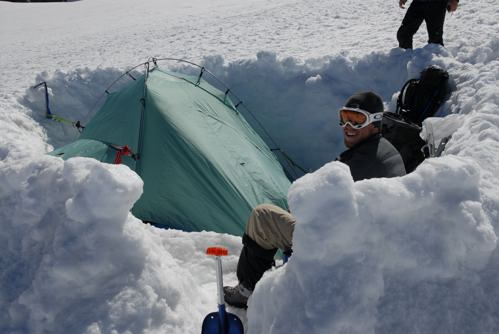 To the right, Above, you see a climber nicely dug in with his tent in place. This type of setup provides excellent protection from the wind, and even helps a bit with the cold since snow is a good insulator under very cold conditions. You will need a lightweight snow shovel to do this kind of work. Also note how the climber has used his ice ax to anchor the tent on the left. We used a snow picket to anchor ours. This is a must, if you do not want to loose your tent in heavy winds.
To the right, Above, you see a climber nicely dug in with his tent in place. This type of setup provides excellent protection from the wind, and even helps a bit with the cold since snow is a good insulator under very cold conditions. You will need a lightweight snow shovel to do this kind of work. Also note how the climber has used his ice ax to anchor the tent on the left. We used a snow picket to anchor ours. This is a must, if you do not want to loose your tent in heavy winds.The climbing guides usually have tents set up on the flats. They can be helpful during their down time on the mountain and are nice enough to answer any questions you may have about the above routes and/or conditions that you may run into. They are going up and down the mountain almost on a daily basis during the heavy climbing months of July and August.
I would have to say that most climbers do not use the Ingraham Flats Camp, and opt to get a very early from Camp Muir and go all the way to the summit from there. We choose an easy second day for our climb, and made use of Ingraham Flats. It certainly makes summit day a lot easier, by having that additional 1000 feet of elevation gain out of the way, and even more importantly, we were able to get some much needed extra rest before having to push for the summit the following day.
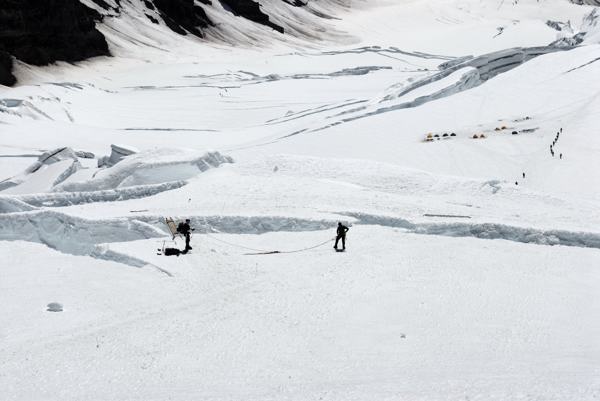 In the photograph to the left, above, you can see far below in the upper right hand corner, Ingraham Flats Camp. Notice that the camp is surrounded by large crevasses. Always remain roped when wandering around areas outside the camp. A hidden crevasse is always a possibility and you certainly do not want to fall into one of them.
In the photograph to the left, above, you can see far below in the upper right hand corner, Ingraham Flats Camp. Notice that the camp is surrounded by large crevasses. Always remain roped when wandering around areas outside the camp. A hidden crevasse is always a possibility and you certainly do not want to fall into one of them.Ingraham Flats, unlike Camp Muir, does not have any toilet facilities, so all solid waste must be packed out. But all in all, we found the Ingraham Flats area, like Camp Muir, to be in a very beautiful setting, and it was a great experience to watch the sun rise and set from such a spectacular location. I found great photo ops on Mt Rainier from start to finish.
So whether you use just Camp Muir, Ingraham Flats or both, you can't go wrong and they have aided countless climbers reach their goal on Mt Rainier over the years.
Email Sign Up
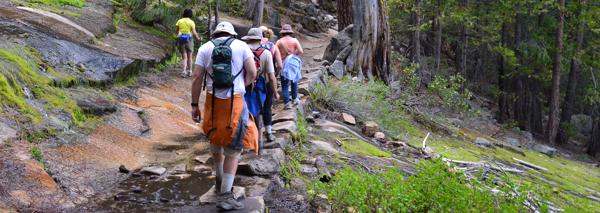
| Join the Adventure! Sign up here for Timberline Trails Monthly Newsletter |

Join us on Instagram

©2006-2024 TimberlineTrails. All Rights Reserved.
....